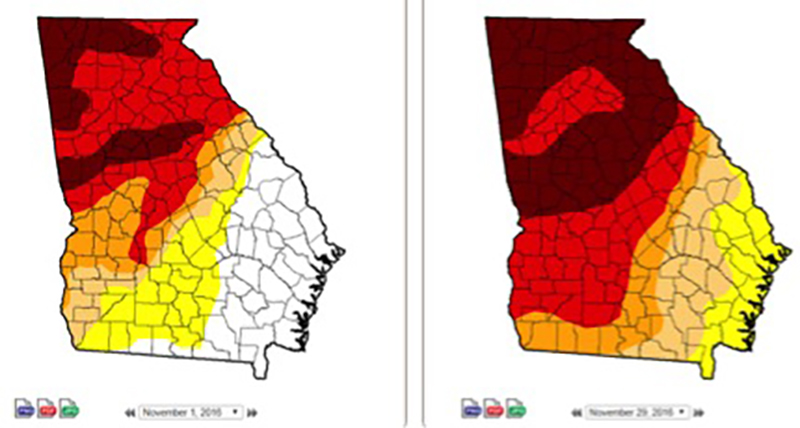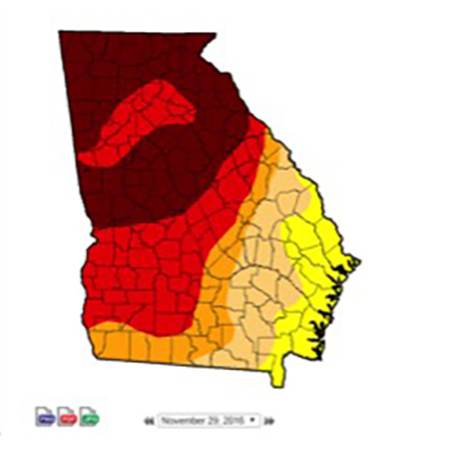Weather conditions were warmer and drier than normal across most of the state during November, causing drought and extremely dry conditions to again expand across Georgia.
While most of Georgia will experience rain in early to mid-December, drier conditions are projected to return by the end of the month.
Only Georgia’s coast and the Savannah River basin remained free from drought conditions by the end of November. But even those areas, affected by hurricanes Matthew and Hermine earlier in the fall, were abnormally dry by the end of the month.
The dry weather allowed farmers to plant onions and harvest cotton and peanuts. However, dry conditions made it impossible for farmers to successfully plant winter grains or forage crops. Those who did saw their plants germinate and then shrivel from the lack of rainfall.
Forest fires in north Georgia and beyond caused respiratory distress in livestock in mid-November, and outpatient visits by people with respiratory issues increased due to the heavy smoke in the area. Some farmers reported being reluctant to run their farm equipment for fear of sparking more fires in the dry fields.
Irrigation from ponds and streams was curtailed due to the low water levels, and several communities requested variances on water restrictions from the state Environmental Protection Division due to problems getting enough water for their communities.
The highest monthly total precipitation reported by a National Weather Service reporting station was 2.98 inches in Atlanta, 1.12 inches below normal.
- Athens, Georgia, received 2.24 inches, 1.58 inches below normal.
- Columbus, Georgia, received 2.18 inches, 1.92 inches below normal.
- Macon, Georgia, received 1.15 inches, 2.17 inches below normal.
- Savannah, Georgia, received 0.20 inches, 2.17 inches below normal.
- Augusta, Georgia, received 0.62 inches, 2.20 inches below normal.
- Alma, Georgia, received 0.28 inches, 2.20 inches below normal.
- Brunswick, Georgia, received 0.04 inches, 1.99 inches below normal.
- Rome, Georgia, received 1.77 inches, 3.08 inches below normal.
- Albany, Georgia, received 1.02 inches, 2.17 inches below normal.
The National Weather Service reporting station at the Brunswick airport recorded its lowest November precipitation total in 69 years, with only 0.04 inches of rain. Savannah saw the seventh-driest November in 147 years of record, with 0.2 inches of rain.
In contrast to previous months, the driest part of the state was the southeast, which experienced less than 25 percent of normal rainfall.
The highest daily rainfall total recorded by Community Collaborative Rain, Hail and Snow (CoCoRaHS) Network volunteers was 3.55 inches near Ringgold, Georgia, in Catoosa County on Nov. 30. Two observers near Trenton, Georgia, in Dade County reported 3.27 and 3.10 inches that morning, and an observer in Fayetteville, Georgia, in Fayette County reported 3.02 inches on Nov. 29.
These CoCoRaHS volunteers also reported the network's highest monthly totals, with the Ringgold observer recording 5.12 inches for the month, followed by the two Trenton observers with 4.37 and 3.23 inches, and the Fayetteville observer recording 3.16 inches for the month.
Above-normal temperatures were once again the story in most of Georgia in November.
- Athens’ monthly average temperature was 56.8 degrees Fahrenheit, 3 degrees above normal.
- Columbus’ monthly average temperature was 59.9 F, 2.6 degrees above normal.
- Macon’s monthly average temperature was 58.4 F, 2.5 degrees above normal.
- Savannah’s monthly average temperature was 61.1 F, 1.8 degrees above normal.
- Brunswick’s monthly average temperature was 63.5 F, 1.3 degrees above normal.
- Alma’s monthly average temperature was 60.3 F, 0.4 degrees above normal.
- Augusta’s monthly average temperature was 57.3 F, 2.1 degrees above normal.
- Albany’s monthly average temperature was 62.2 F, 3.5 degrees above normal.
- Rome’s monthly average temperature was 54.9 F, 4 degrees above normal.
- Valdosta, Georgia’s monthly average temperature was 61.2 F, 1.3 degrees above normal.
It was the fourth-warmest November on record in 139 years for Atlanta, after 1985, 2001 and 1931.
A number of record highs were tied or set in November. Athens broke its record high on Nov. 3, observing 85 F to pass the old record of 84 F set in 2000. Augusta also broke its record high that day, observing 87 F, which surpassed the 86 F record set in 1974. Alma broke its record high on Nov. 29, observing 82 F.
Severe weather reported this month included a single high-wind report on Nov. 29 as the cold front began to enter the state, as well as multiple high-wind reports and at least four tornadoes, which were observed near Atlanta on Nov. 30.
For more information, please see the Climate and Agriculture in the South East blog at blog.extension.uga.edu/climate or visit www.gaclimate.org. Please feel free to email pknox@uga.edu with reports of weather and climate's impact on Georgia agriculture.








